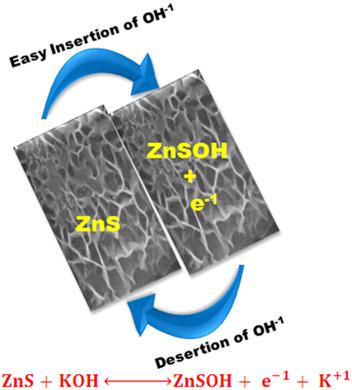当前位置:
X-MOL 学术
›
ChemElectroChem
›
论文详情
Our official English website, www.x-mol.net, welcomes your
feedback! (Note: you will need to create a separate account there.)
Effect of Graphene Oxide Thin Film on Growth and Electrochemical Performance of Hierarchical Zinc Sulfide Nanoweb for Supercapacitor Applications
ChemElectroChem ( IF 3.5 ) Pub Date : 2018-07-24 , DOI: 10.1002/celc.201800633 Muhammad F. Iqbal 1, 2, 3 , Mahmood‐Ul‐Hassan 1 , Aamir Razaq 4 , Muhammad N. Ashiq 5 , Yusuf V. Kaneti 2 , Azhar A. Azhar 2 , Farhat Yasmeen 6 , Khurrum Saleem Joya 6, 7, 8 , Shafqat Abbass 5
ChemElectroChem ( IF 3.5 ) Pub Date : 2018-07-24 , DOI: 10.1002/celc.201800633 Muhammad F. Iqbal 1, 2, 3 , Mahmood‐Ul‐Hassan 1 , Aamir Razaq 4 , Muhammad N. Ashiq 5 , Yusuf V. Kaneti 2 , Azhar A. Azhar 2 , Farhat Yasmeen 6 , Khurrum Saleem Joya 6, 7, 8 , Shafqat Abbass 5
Affiliation

|
Surface morphology induced electrical conductivity and specific surface area of a material play a significant role to facilitate electrochemical behavior for supercapacitor application. Therefore, the synthesis step for controlling such parameters becomes very imperative and challenging. Herein, a ZnS nanoweb is deposited directly onto Ni foam with a pre‐deposited thin layer of hydrothermally prepared graphene oxide. The structure and surface morphology of the deposited ZnS is observed using XRD and SEM, respectively. The electrical conductivity of the graphene oxide supported ZnS nanoweb, determined using the four probes method, is 100.15 S cm−1. The specific surface area is 104.42 m2 g−1 as determined by BET measurements. Pseudocapacitive behavior is monitored by cyclic voltammetry, and the excellent specific capacity of 3052 Fg−1 has been found at a scan rate of 2 mV s−1, while it is 2400.30 Fg−1 according the galvanostatic charge‐discharge profile at a current density of 3 mA cm−2. Both values are significantly higher than those measured for bare GO or ZnS layers. The energy and power densities of GO supported ZnS nanoweb are determined in a three electrode setup, are 120 Wh Kg−1 at 3 mA cm−2 and 4407.73 Wkg−1, respectively. In a symmetric two electrode setup, an energy density of 20.29 Wh Kg−1 at 2 mA cm−2 is observed. Hence, both symmetric and asymmetric measurements suggest that GO supported ZnS nanoweb can be applied as a suitable electrode for supercapacitors.
中文翻译:

氧化石墨烯薄膜对用于超级电容器的分层硫化锌纳米纤维网的生长和电化学性能的影响
材料的表面形态诱导的电导率和比表面积在促进超级电容器应用的电化学行为方面起着重要作用。因此,用于控制此类参数的合成步骤变得势在必行且具有挑战性。在这里,ZnS纳米纤维网直接沉积在具有预热水氧化石墨烯薄层的泡沫镍上。分别使用XRD和SEM观察沉积的ZnS的结构和表面形态。使用四探针法确定的氧化石墨烯负载的ZnS纳米纤维网的电导率为100.15 S cm -1。比表面积为104.42 m 2 g -1由BET测量确定。赝电容行为是由循环伏安法,和3052 FG的优异的比容量监测-1以2毫伏s的扫描速率已经发现-1,而它是2400.30蛋白原-1根据在电流密度恒电流充放电曲线为3mA cm -2。这两个值均显着高于裸GO或ZnS层的测量值。GO负载的ZnS纳米纤维网的能量密度和功率密度是在三电极设置中确定的,在3 mA cm -2处的能量密度和功率密度分别为120 Wh Kg -1和4407.73 Wkg -1。在对称的两电极设置中,在2 mA cm处的能量密度为20.29 Wh Kg -1观察到-2。因此,对称和非对称测量都表明,GO支撑的ZnS纳米纤维网可以用作超级电容器的合适电极。
更新日期:2018-07-24
中文翻译:

氧化石墨烯薄膜对用于超级电容器的分层硫化锌纳米纤维网的生长和电化学性能的影响
材料的表面形态诱导的电导率和比表面积在促进超级电容器应用的电化学行为方面起着重要作用。因此,用于控制此类参数的合成步骤变得势在必行且具有挑战性。在这里,ZnS纳米纤维网直接沉积在具有预热水氧化石墨烯薄层的泡沫镍上。分别使用XRD和SEM观察沉积的ZnS的结构和表面形态。使用四探针法确定的氧化石墨烯负载的ZnS纳米纤维网的电导率为100.15 S cm -1。比表面积为104.42 m 2 g -1由BET测量确定。赝电容行为是由循环伏安法,和3052 FG的优异的比容量监测-1以2毫伏s的扫描速率已经发现-1,而它是2400.30蛋白原-1根据在电流密度恒电流充放电曲线为3mA cm -2。这两个值均显着高于裸GO或ZnS层的测量值。GO负载的ZnS纳米纤维网的能量密度和功率密度是在三电极设置中确定的,在3 mA cm -2处的能量密度和功率密度分别为120 Wh Kg -1和4407.73 Wkg -1。在对称的两电极设置中,在2 mA cm处的能量密度为20.29 Wh Kg -1观察到-2。因此,对称和非对称测量都表明,GO支撑的ZnS纳米纤维网可以用作超级电容器的合适电极。











































 京公网安备 11010802027423号
京公网安备 11010802027423号